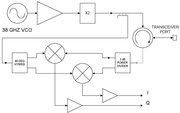Circuit diagram
|
|
4_bit_counter.png
A circuit diagram (also known as an electrical diagram or electronic schematic) is a pictorial representation of an electrical circuit. It shows the different components of the circuit as simplifed and standard pictograms, and the power and signal connections (buses) between the devices. Arrangement of the components and interconnections on the diagram does not usually correspond to their physical locations in the finished device.
Unlike a block diagram or layout diagram, a circuit diagram shows the actual wire interconnects being used (although the picture does not have to correspond to what the circuit actually looks like).
| Contents |
Legends
Circuit_elements.png
On a circuit diagram, the components are given with a descriptor matching that on the list of parts. For example, C1 is the first capacitor, L1 is the first inductor, Q1 is the first transistor, and R1 is the first resistor. The letters that precede the numbers go back well before even the vacuum tube (thermionic valve), so "Q" was the only one available for semiconductor devices in the mid-twentieth century. Often the value of the component is given on the diagram beside the part, but detailed particulars would go on the parts list.
Symbols
Circuit diagrams have differed from country to country and have changed over time. The symbol for a resistor shown here dates back to the days when that component was made from a long piece of wire wrapped in such a manner as to not produce inductance, which would have made it a coil. These wirewound resistors are now used only in high-power applications, smaller resistors being cast from carbon composition (a mixture of carbon and filler) or fabricated as an insulating tube or chip coated with a metal film. To illustrate this, European circuit diagrams have replaced the zig-zag symbol by a simple rectangle, sometimes with the value in ohms written inside. A less common symbol is simply a series of peaks on one side of the line representing the conductor, rather than back-and-forth as shown here.
Linkages
Schematic-junctions.png
1. Old style connection.
2. Old style, no connection.
3. Early CAD style, connection.
4. Early CAD style, no connection.
5a, 5b. Modern style, connection.
6. Modern style, no connection.
The linkages between leads were once simple crossings of lines; one wire insulated from and "jumping over" another was indicated by it making a little semicircle over the other line. With the arrival of computerized drafting, a connection of two intersecting wires was shown by a crossing with a dot or "blob", and a crossover of insulated wires by a simple crossing without a dot. However, there was a danger of confusing these two representations if the dot was drawn too small or omitted. Modern practice is to avoid using the "crossover with dot" symbol, and to draw the wires meeting at two points instead of one.
External links
- GNU EDA-Tool used for schematic circuit design (http://www.geda.seul.org).de:Schaltplan

